Introduction
This is a list of the books I brought along on a trip to Washington State. I use these lists myself when I go back to an area, hence the personalized style. Plus, it would be boring to just write it up all school-like. Most of the books mentioned are plant field guides, though I include some maps and other books that may be helpful for the region covered.
One of the limiting considerations in describing these books is the amount of time I had in the different places I decamped. The place I spent the most time was in the Wenatchee National Forest south of Leavenworth, towards the interior of Washington. The other place I got to field-test them was in Gifford Pinchot National Forest in southwest Washington.
In the book review section below, I have divided the books up by those which I used most to those least used.
One thing that is a consideration for me is how well a book is physically made, and you will see this peppered through my reviews. The reason is that field guides (at least mine) get treated roughly, thrown in my backpack and dragged out in all kinds of weather. So a well-made volume is a consideration in its own right.
Throughout these notes instead of calling books by their title, I usually use the author’s name. This is a common convention and if you look at the book titles, they are all similar, so it makes it more distinguishable. The book list below has the authors and titles together for reference.
One of the things I found odd is the reliance of botany types on using mainly Plants of the Pacific Northwest by Pojar and Flora of the Pacific Northwest by Hitchcock and Cronquist. While Hitchcock is indispensible for this region, I was surprised more folk were not using Wildflowers of the Pacific Northwest by Turner and Gustafson and Plants of Western Oregon, Washington, and British Columbia by Kozloff. I made it my business to let as many people know about the latter two books. I guess they are relatively recent (often a plus in this kind of literature) and not in wide circulation.
I find it helpful to have a few different floras that are not copied from each other. Often the difference between two species is minute, and different authors handle these details differently, and between two or more it can be much easier to settle on a species.
I purchased some books from Amazon.com using their reviews, and this worked well for me, as I purchased two useful books I would not have know about otherwise.
Definitions
I want to define two terms that get used frequently in this review which are ‘flora’ and ‘keying out’. While the word flora is often used to describe plants in general (i.e., flora and fauna), with field guides it commonly refers to a book that has all the plants of a region. An example would be the Flora of the Pacific Northwest, which indicates it includes all the plants of the area delineated in the title. When trying to identify plants to their species these books are a boon, because it is hard to know which species you have without knowing all the plants that it might be in a given region.
Keying out is a process used in identifying plants. You are given a set of statements (usually two at a time) and you choose the more correct choice. After that you are given another set until you finally get to the (hopefully) right plant. This is the way most floras are written as it is a useful format. A different style might be a book that has all the flowers of a certain color near each other in the book. While this can initially helpful, you would need more clues to get to know which species it is, as the differences can be subtle.
The Complete Book List
- Flora of the Pacific Northwest-Hitchcock and Cronquist
- Flora of the State of Washington (1906)-Piper
- Mountain Plants of the Pacific Northwest-Taylor and Douglas
- Northwest Weeds-Taylor
- Plants of the Pacific Northwest-Pojar and Mackinnon
- Plants of Western Oregon, Washington, and British Columbia-Kozloff
- Washington Wildflowers-Larrison et al
- Wayside Wildflowers of the Pacific Northwest-Strickler
- Wildflowers of the Pacific Northwest-Turner and Gustafson
Other Resources
- Marc Williams checklists-Part of my time on this trip was at the Rainbow Gathering and every year Marc makes a thorough list culled from various resources of the plants in the area that the Rainbow Gathering will be. This list is very helpful, and I make sure to print out a few copies before leaving.
- Plant lists from ranger stations-When I pass a ranger station for an area I will be in for a while, I stop in and see if they have a species list for that region. Sometimes the front desk people may not know, so ask if they have a staff botanist, and if she or he is in. Besides knowing if they have a list or not, they often know some of the best places to go see plants. I have had many good conversations about a region this way.
Books Used The Most Frequently
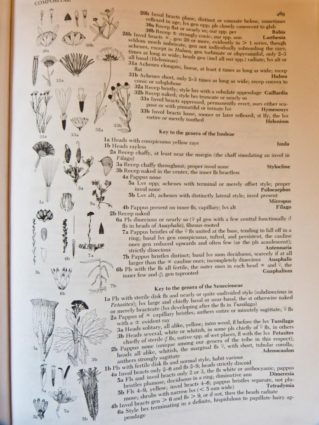
Flora of the Pacific Northwest-Hitchcock and Cronquist
This is the standard flora for this region, and that alone makes it important to
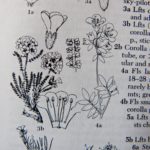
understand, as this is the book most folks will use for keying out plants.
The good; it is a straightforward useful tome for the working botanist. It has small but practical black and white line illustrations for most species with important botanical details helping to highlight the individual differences. It is well made and while large it is not too heavy.
My least favorite aspect of this book is the short individual plant descriptions for each species. When you arrive at the species in the key, that is where the plant description is located. This is as opposed to other technical floras where after you key to the species you then go to a through species description. But in general the information provided is enough to decide if you have the correct species. And to be fair, this dramatically cuts down on the size and weight of the book.
There really is no major downside to this flora. It may be a bit outdated, and the illustrations and descriptions a bit small, but it works, and that is the most important detail.
The keys from this book, along with the keys in Kozloff were really helpful together in identifying many species.
Plants of Western Oregon, Washington, and British Columbia-Kozloff
This review starts with a quick story. I was preparing for my trip to Washington and looking through the Amazon book reviews for plant field guides for books I did not know about and kept seeing this book with excellent reviews, but knew no one who used it (and I have many NW botany friends). But I found a used copy for $12 (good price!) and purchased it. And I am sure glad I did, it is an excellent flora for the region it covers.

I knew some of Kozloff’s work having his useful Plants and Animals of the Pacific Northwest (see below). And this flora is from 2005, much more current than Hitchcock and Cronquist. As soon as I got it, I could see that it was a thoughtful, well-done flora, but its value became evermore so apparent as I started using it in Washington.
I wondered if Kozloff was a pariah of some kind since I didn’t know anyone using this book, but it just seems that Hitchcock and Pojar are the standard.
This book is good as a stand-alone flora and better as an adjunct with Hitchcock.
Like all field guides it has its up and downsides. Beginning with the positive, it often got me to the plant species I was looking at, which is the most basic goal of any flora. It has a good sprinkling of useful black and white line illustrations, and very helpfully, over 700 color photographs. They are of a good size and quality, and often with a black background helping highlight the various botanical aspects of the plants.
The keys are well thought out and generally helpful. One can see that the author has not just copied these keys from various books, but has spent time revising and devising new keys. As can be expected this works some, but not all of the time. The nomenclature is more up to date, and while he may still use older families (i.e., Scrophulariaceae) for plants now placed in different families, there are notes pointing this out.
Okay, some of the difficulties. What Kozloff has admirably done, is re-worked many of the standard plant keys. The problem is sometimes his keys were particularly vexing, but that is why I carry more than one flora when I have the opportunity. And it was very helpful to use this book to balance out what I could not figure out in Hitchcock.
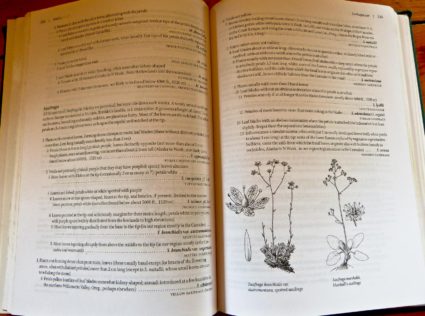
Also, like in Hitchcock, the description of a species is within the key, rather than a separate and more thorough description. So even after getting to a species, it could be hard to ascertain the species. And again setting it up this way keeps the size of the volume down, an important feature when trudging a number of field guides around
To sum up, this is a very useful flora. The author clearly has an extensive working relationship with the plants and has revised and reworked older flora’s adding updated and new information as well as his personal observations of the plants. The color photos are lovely and useful, as well as the black and white line illustrations. Some of the keys are a bit baffling and the descriptions are rather brief, but all in all, this is an excellent plant field guide for the region, and one I am very glad to have had along.
Note: A problem for me was that I took this with me into the Wenatchee National Forest in central Washington, and this book does not cover that area as well, as it is not ‘Pacific Northwest’. I then supplemented it with Washington Wildflowers.
Wildflowers of the Pacific Northwest-Turner and Gustafson
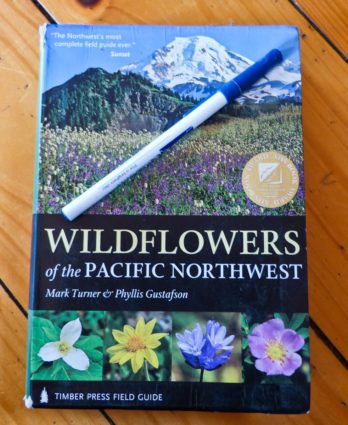
This book is new to me, and was glad I purchased it. There are a number of reasons I like it, but above all, it helped me identify a number of species. I used it in conjunction with more technical floras (Hitchcock and Kozloff).
It has a basic key dividing the plants by obvious flower color and then the number of petals, symmetry, and a few other basic clues. This is rudimentary but helpful to get to a starting point, and that is why I used it in conjunction with other plant keys.
The book is well made and a good carriable size. It has a useful section on the ecosystems covered which was helpful for me not being familiar with the different regions of Washington State.
Onto the main reasons I found this book so useful. First, just the number of species covered (1220) means that there is a good chance the plant I am looking at it is included, which I found to be the case. Next, the photos, while small, and mainly just one per plant species are well done, meaning that the photo contains enough useful characteristics to help with plant identification.
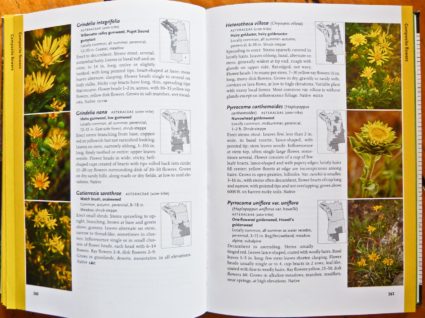
While the photos are helpful, a drawback to this book is the lack of photos highlighting other details of a species or even better might be black and white illustrations. But one field guide can’t be one thing for all people, so once again the need to use other field guides along with this one.
It contains useful range maps for each species, and while the plant descriptions are concise and size-limited, I found the information useful.
In other words, while this book has its limitations the quantity of plants covered along with good quality photos and descriptions, rudimentary keys in a smallish volume, helped me identify many of the plants I did not know.
I strongly suggest purchasing this book for anyone who lives in its region.
Books Used Less Frequently
Plants of the Pacific Northwest-Pojar and Mackinnon
This is one of the mostly commonly wielded field guides for the region (along with Hitchcock and Cronquist). It is not my preferred field guide though.
It is a useful plant guide. It is a well made and a carriable size. It contains many plants, tilting the chances that you will find the one in your hand. It contains a few color photos of the plants featured often accompanied with black and white illustrations, an excellent combination. There are keys for many plant families, and some of the genera (Rubus, and Pedicularis for instance) are keyed to species. And in Hitchcock fashion, some of the keys have small black and white drawing helping to illustrate the key.
A helpful aspect of this book is that it includes trees, shrubs, ferns, grasses, mosses, liverworts and lichens. In other words, very inclusive of the whole diversity of plants, not just the more obvious flowering ones.
There is a ‘Notes’ section to each plant with a lot of interesting information. First, it discusses the different botanical information, such as other species within the same genera. It often has a wide variety of native uses, making this book the most useful if you are interested in how a plant is/was used. And it often explains what the genus and species mean, such as whom it was named after.
All of this strongly recommends this book, and yet I do not use it often. There are a number of reasons for this, some may seem picayune, but nevertheless they limit my use.
First, and most importantly, I don’t find it that useful for trying to initially identify a plant’s genus nor especially its species, which is the main reason I bring along field guides. I find other field guides more helpful in deciphering a plant’s identity The reason for this, is that while it does have keys to many genera and some species (and very helpful keys for the trees), I still find it easier to use Hitchcock or Kozloff. The descriptions in this book are good, but since they pack a number of species under one genus, it can be difficult to ascertain which species I am looking at. This book is helpful at having the most common species represented, the plants you are most likely to encounter.
And for me, I would rather not have all the information on uses but instead look up that information elsewhere and have that space devoted to differentiating species. Also, I do not find the photos so useful, a little too small, leaving out important details. Perhaps I am being unfair here, but I would like to use this book more often and these are the reasons I do not.
I can imagine that many people would like this book for many of the above reasons. Perhaps and updated version some day?
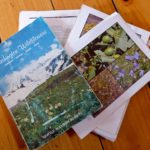
Washington Wildflowers-Larrison, Patrick, Baker and Yaich
I didn’t start using this book until later on in my trip which was too bad as it quite useful. I do need to point out, as this is my second copy, that it is a very crappily made book. The binding breaks and pages fall out no matter how it is pampered, as it is made with a poorly glued binding. Oh well, at least it is not too expensive (less than $1 on Amazon today). There are 2 main reasons it is so useful. Primarily because it is Washington specific, and just as important, it has floral keys. All of the other books I used are for the Pacific Northwest, meaning I have to plow through many plants that I will not be seeing. Plus, it covers all of Washington State including the drier east side.
It does have some color and black and white photos, but they are the old-type and of limited use. But I repeat, it has reasonable keys, and using this book along with Hitchcock, and Kozloff, it is possible to identify many of the plants of Washington, including the more inland regions where I used it. And while the descriptions are short, they are longer than Hitchcock. If you live or botanize in Washington, I recommend it.
Books Used Infrequently
Mountain Plants of the Pacific Northwest-Taylor and Douglas
This book is useful due to the good-sized color photos and helpful descriptions, including trees, club mosses, horsetails and ferns. Some of the plants have a number of different photos for the same plant, showing variation and different aspects which is especially helpful with some of the trees covered. I would recommend this book (perhaps along with Strickler’s below) for those wanting a good color photo plant book. I would recommend Turner and Gustafson alongside this.
Flora of the State of Washington (1906)-Piper
It would seem that this flora would be very useful due to its specificity, but I did not find it so for a number of reasons. As could be imagined, a book that is 106 years old has some outdated terminology. And the main reason that I did not use it much is that the newer volumes had the information without the outdated terminology. I was still glad to have it to see if a plant I was keying out even grew in Washington, though Washington Wildflowers covered that realm well enough. If I spent more time in Washington I may use this volume more to compare with other books. Many of the keys from this book seem to be have been incorporated into newer volumes. Such is the way.
Books Not Used
Plants and Animals of the Pacific Northwest-Kozloff
I did not use this book mainly due to the lack of time I had to explore the animal life. While the photos are of an older type they are still useful, especially of the non-flowering plants and animals. It is still one of the most useful all-around field guides to the various life in the Pacific Northwest. Aside from the photos, the author clearly has spent a lot of time outside in this region and has a depth of knowledge which shows in his writing. If the photos were updated, this would be a much better volume, but it is still worth having to learn about life in the Northwest.
Wayside Wildflowers of the Pacific Northwest-Strickler
This is one of those books that is quite attractive with its good-sized color photos and brief descriptions of the plants covered. It does a good job of covering the more commonly encountered wildflowers and its best use would be for either a quick check-up on a plant or to see a color photo after keying it out. And it is the large size of the photos that makes this book a little better than some others. It would work well in conjunction with Turner and Gustafson.
Northwest Weeds-Taylor
I did not use this book as I was busier in the bush than amongst the weedier places. However if I were wandering amongst gardens, old fields or roadways, this would be a handy identification guide to have. The medium-sized photos are only so-so, but what it does well is cover those plants that we see most often in disturbed habitats. It occasionally has a few photos of the same plant from different angles, a helpful detail. You may not be able to know exactly which plant you have from this book, but you will likely get close enough to the species and learn the plants that often accompany humans in our habitat altering endeavors.
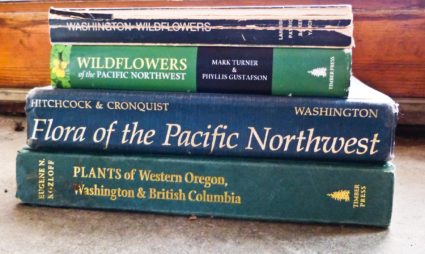

THanks 7Song. Informative. Wondering how helpful the “Wildflowers of the PNW”-Turner and Gustafson, would be Idaho?
It looks very interesting, and I like the size as a carrying companion to Flora of PNW.
What are your thoughts?
I am not sure about Turner and Gustafson where you live Jim, my guess is that there may be some overlap, and where there is, it would be helpful. Considering that it’s not too expensive, I think it would be worth a try. I need to explore Idaho more. ~7Song
Thanks for the thorough review 7song…Just got Turner and Gustafson for my current westward trip! Appreciate the acclaim for the plant list making too! Cheers, marc
Your lists are helpful every year Marc, glad to let other people know (though now you may need to make them more widely available). I think you’ll like Turner and Gustafson, let me know.
~7Song
Hello there, thank you so much for this helpful breakdown of plant guides. I was wondering if the Cronquist and Hitchcock book included Northern California. Thanks so much!
Hello Lauren. There would probably be some cross-over info for N. California, but since California already has a very good field guide, I would use that one. That field guide is The Jepson Manual-Vascular Plants of California. If you purchase that one, make sure to get the newest edition. You can find it on Amazon.
I hope this helps, 7Song